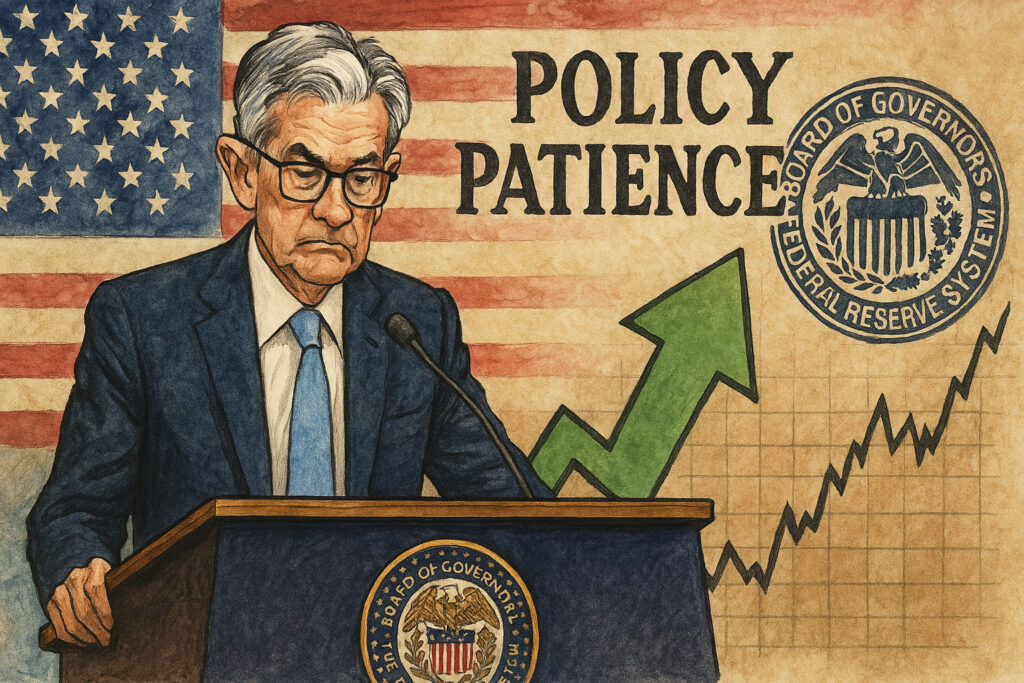On March 5, 2025, U.S. equity markets rallied after Federal Reserve Chair Jerome Powell delivered his semiannual testimony to Congress, signaling a continued patient stance on interest rate policy. Powell’s comments, delivered before the Senate Banking Committee, emphasized that the central bank sees progress on inflation and is not in a hurry to either raise or cut interest rates.
Key Takeaways from Powell’s Testimony
Chair Powell’s remarks were carefully measured, reinforcing the Fed’s commitment to its dual mandate—maximum employment and stable prices—while also acknowledging recent improvements in economic data.
“We are seeing encouraging signs that inflation is coming down sustainably,” Powell said, “but we need to see more evidence before making any adjustments.”
This statement reassured markets that the Fed would not rush into another rate hike, particularly as inflation metrics have shown moderation. His tone was widely interpreted as dovish compared to the aggressive tightening seen in 2022–2023.
Market Reaction: Stocks Surge Across the Board
Markets responded positively across the board:
- S&P 500 closed up +1.4% at 5,198
- Nasdaq Composite jumped +1.9% to 16,045
- Dow Jones Industrial Average gained +1.1%, ending at 39,220
Interest rate-sensitive sectors like tech and real estate led gains, with major tech names like Apple (+2.3%), Nvidia (+3.1%), and Microsoft (+1.8%) all pushing higher.
The 10-year U.S. Treasury yield dipped slightly to 3.94%, reflecting bond investors’ confidence in a stable rate environment.
A Closer Look: Inflation, Labor Market, and the Path Forward
Inflation Cooling, but Not Conquered
February’s CPI report showed a 3.2% YoY increase, down from a peak of over 9% in 2022. Powell acknowledged the progress but reiterated the need for caution, especially amid sticky core inflation.
Markets are now pricing in a roughly 45% probability of a rate cut by June 2025, according to CME FedWatch data. This is slightly up from 38% the day before.
Labor Market Resilience
The labor market remains strong, with the unemployment rate holding steady at 3.7%. Powell noted that wage growth has moderated without significant job losses—an encouraging sign for a soft landing scenario.
Balance Sheet Reduction and Liquidity
Powell also addressed questions about the Fed’s ongoing balance sheet runoff, confirming that it will continue, but at a moderated pace to avoid market disruptions. Liquidity conditions remain robust, with the Fed Funds rate range held steady at 5.25%–5.50%.
Global Market Spillover
Global markets echoed the U.S. rally:
- Euro Stoxx 50 rose +0.9%
- FTSE 100 gained +0.7%
- Nikkei 225 climbed +1.6%, reflecting optimism in U.S. monetary policy and robust tech demand in Asia
Emerging markets and currencies like the Mexican peso and South Korean won also strengthened, as the dollar softened slightly after Powell’s remarks.
Analyst Commentary: Strategic Patience Is the Watchword
Wall Street analysts praised Powell’s tone, suggesting the Fed is navigating the transition from tightening to neutrality with poise.
“This was a masterclass in central bank communication,” said Lindsey Piegza, Chief Economist at Stifel. “Markets were desperate for confirmation that the Fed won’t overdo it—and Powell delivered.”
“Patience is the theme,” echoed BlackRock strategist Rick Rieder. “The Fed wants to see real disinflation before moving, but they’re also cautious not to break anything along the way.”
Investor Outlook: What Comes Next?
While Powell didn’t provide a firm timeline for the next policy move, markets are now focused on the upcoming Nonfarm Payrolls Report (March 7) and CPI (March 12) for clues. These data points will likely shape expectations heading into the next FOMC meeting on March 20.
Strategy Notes:
- Equity investors may see this as a green light for rotation into tech and growth stocks.
- Bond markets could remain range-bound with low volatility until the next inflation data drop.
- Commodities like gold pulled back slightly (-0.6% to $2,080/oz) as risk appetite returned.
Conclusion
Chair Powell’s testimony marked a pivotal moment of reassurance to markets, signaling that the Fed is not looking to tighten further unless absolutely necessary. This policy patience—backed by improving inflation and a resilient labor market—helped push risk assets higher across the globe.
Investors will remain attuned to economic data and Fed communication, but for now, Powell has managed to walk the line between hawkish caution and dovish flexibility—a rare feat in today’s policy landscape.
Disclaimer: This article is for informational purposes only and does not constitute financial advice. Always consult with a professional before making investment decisions.
